After working on training a solid down in the August play groups, settle is a nice behavior to follow up with. The goal of teaching “settle” is to cue a sequence of behaviors – you say “settle” and your dog goes to their bed, lays down, and relaxes. A relaxed dog, one who isn’t actively soliciting attention or play, is the final goal. When teaching settle, we typically rely on capturing as our primary training technique. Capturing is waiting for our dogs to do something we like and then reinforcing it. Capturing uses the basic rule of dog training – reinforce something you like, and it will happen more often. You can learn more about this technique in our December 2014 blog posting.
To teach “settle” you can start by laying down a mat, bed, or blanket for your dog and then use your most reliable signal to cue them to lay down on it. Treat your dog as soon as they are laying down. Now give your dog a treat after every second they stay in the down position. After working through 10 one-second intervals and giving your dog 10 treats, switch to giving them a treat every 2 seconds. Give your dog a treat every 2 seconds, this time only five times in a row. Then switch to 4 seconds. Again, do this five times in a row. Then switch to 6 seconds. Stay calm and offer some calm praise when your dog stays on the mat or bed. Work in this way all the way up to 30 seconds.
Now, once your dog can lay on their bed for 30 seconds without getting up, watch for any calm, relaxed body language, such as changing their body position to settle back on one hip or on their side. As soon as you see this, capture it by praising them when you see it and following your praise with a food treat. We’re now rewarding examples of relaxed behavior in your dog. Watch their muscles relax and praise them calmly and give a treat. See a furrowed brow relax, praise and treat. Do the same when they rest their head down on the bed.
Depending on your dog’s age, activity level, and training history, the length of the first few training sessions will vary. For younger, active dogs, you may need to end the first few training sessions after 10-30 seconds of calm, relaxed behavior. For older dogs, you might end the training sessions after 1-3 minutes of calm, relaxed behavior. In either case, you want the training session to end with success, in other words you want to end the session before your dog starts to get up. To do this, let your dog know the training session is done when they are still relaxed on their mat by using a release cue (such as “ok” or “free”) or cue a different activity such as “let’s play” or “let’s walk.”
You can also capture a settle without any prompting, by just waiting for your dog to lay down and relax. As soon as they are in a calm, relaxed body position, you can click or say “yes” and give them a treat or pet them (if they like attention as much as a treat). At first, your dog may be surprised by this new game, but it won’t take her long to figure out that she can get you to click and treat or get attention when she is calm and relaxed.


